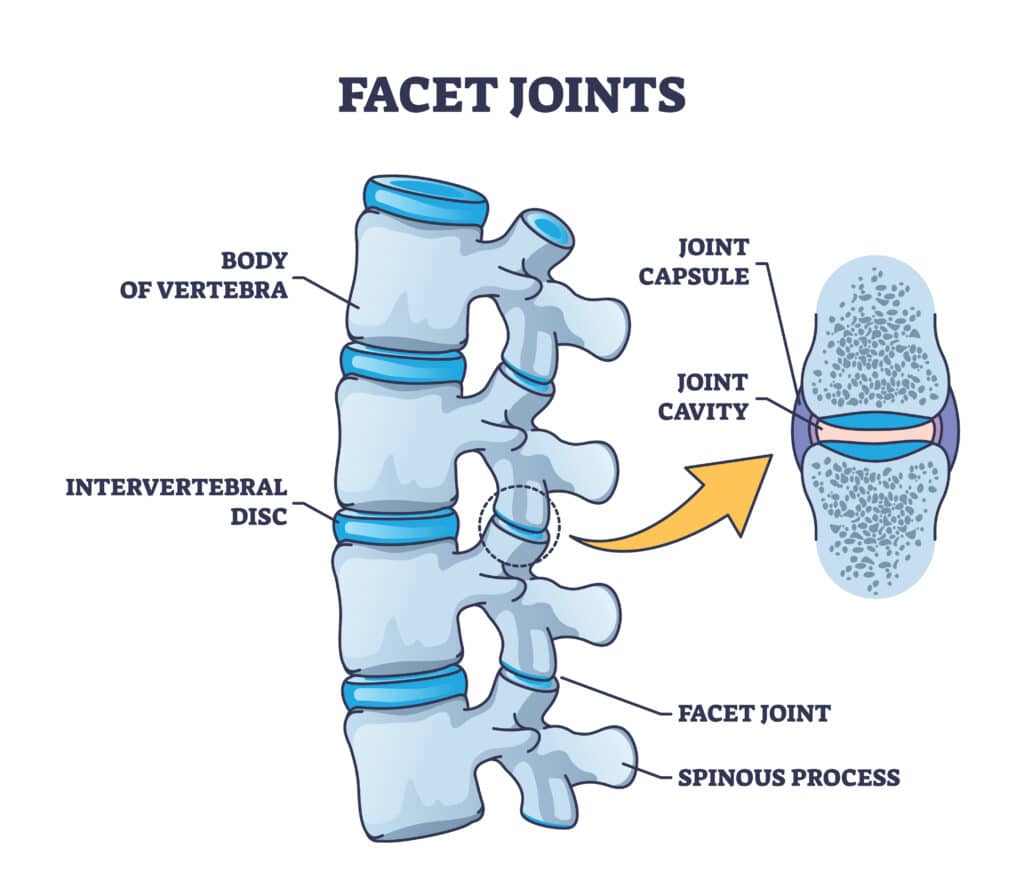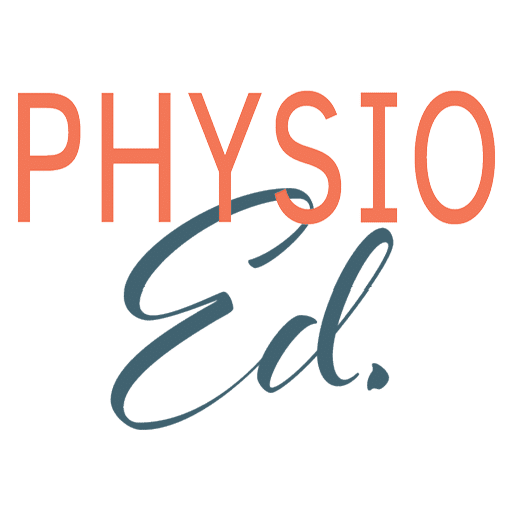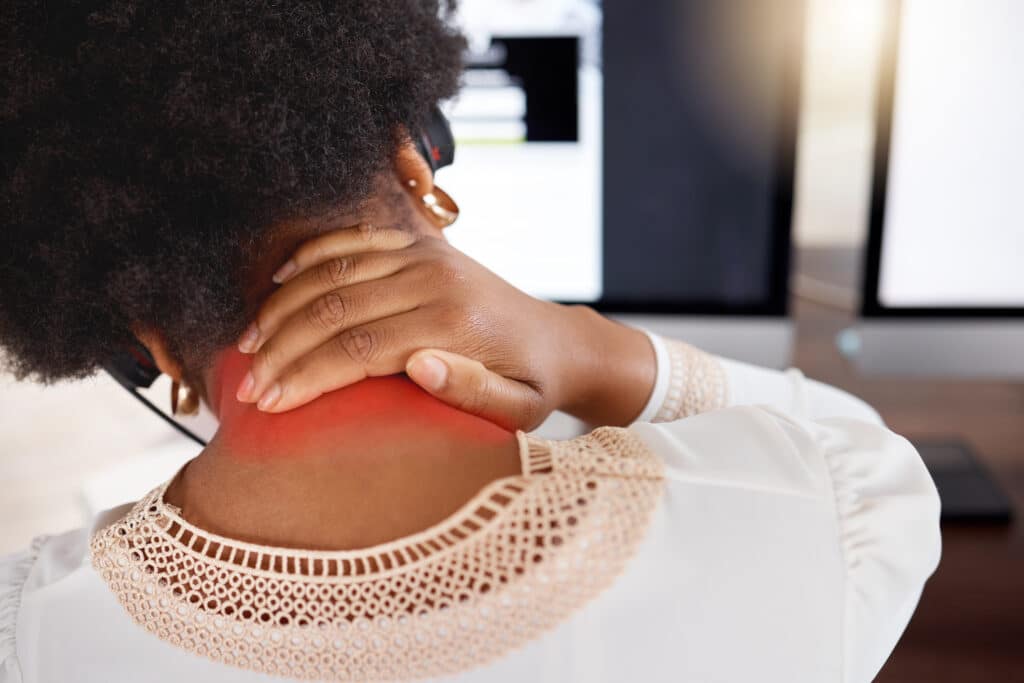Are you dealing with a crick in the neck? This is a common problem for many people, but why does it happen in the first place?
Understanding the causes and managing this discomfort can significantly relieve this common complaint. It’s sometimes difficult to describe this feeling besides calling it a tweak, hitch, catch, or even a kink, but for most older adults, it seems to have some driving characteristics.
This “crick” usually happens on one side and worsens with head turns in either direction. It is often imperceptible when the head or neck is in a neutral position and looking straight ahead.
No matter which words you use to describe it, you know the feeling: sharp, localized pain that sometimes seems to come out of nowhere and limits your rotation from side to side.
In this article, we’ll explore the anatomy of the neck and common triggers for neck cricks. We’ll discuss prevention strategies and provide immediate relief measures. Finally, we’ll highlight when to seek professional help and outline long-term management and rehabilitation techniques to deal with a pesky crick in the neck.
Understanding the Anatomy of the Neck

The neck is a complex structure composed of muscles, ligaments, and vertebrae that support the head and facilitate movement.
When these components are out of alignment, stiff, or strained, it can lead to a crick in the neck. Understanding how these structures interact can show how a “kink” or “crick” in the neck may occur.
Let’s take a deeper look:
Muscles of the Neck
When the muscles in your neck are stretched or contracted excessively, they can become irritated and inflamed, causing discomfort and restricted movement.1
The neck contains several layers of muscles that work together to support the head and facilitate movement.
Muscles can become tense or strained due to poor posture, repetitive movements, or stress. As a result, they may develop areas of tightness or spasms, leading to discomfort and limited mobility.
Ligaments in the Neck
Ligaments are tough bands of connective tissue that connect bones to other bones, providing stability to the neck joints. In the cervical spine, certain ligaments help support the vertebrae and prevent excessive movement.
If these ligaments become stretched or irritated due to sudden movements or chronic stress, they can contribute to neck instability or stiffness.
The Cervical Vertebrae

The cervical spine consists of seven vertebrae (C1-C7) stacked on each other and separated by intervertebral discs. These vertebrae support the head and protect the spinal cord.
The joints connecting one vertebra to the next are called facet joints.
Disruption of the vertebrae’s normal alignment or movement, such as sudden twisting or bending motions, trauma, or arthritis/degenerative disc disease, can lead to irritation of the surrounding tissues, facet joints, and muscles, resulting in discomfort and restricted movement.
Nerves of the Neck, Shoulder, and Arm
The neck contains a network of nerves that transmit signals between the brain and the rest of the body.
The cervical nerves, which branch off the spinal cord and exit through small openings between the vertebrae, innervate the muscles, skin, and other structures of the neck and upper extremities.
Compression or irritation of these nerves, such as from a herniated disc or bone spur, can cause pain, numbness, tingling, or weakness in the neck and arms.
When these anatomical structures are disrupted or strained due to poor posture, repetitive movements, sudden trauma, or underlying medical conditions, the sensation might be described as a “crick in the neck.”
Discomfort might feel like stiffness, soreness, or limited range of motion and may require various treatment approaches to alleviate symptoms and restore normal function.
Common Triggers for Neck Cricks

Neck discomfort is a common complaint due to poor posture, sleep habits, repetitive movements, and stress.
Let’s explore these common triggers for neck cricks and preventive measures to alleviate discomfort and promote neck health.
The Role of Posture
Slouching or hunching places undue strain on the neck and upper back muscles. When you slouch, the cervical spine’s natural curve becomes exaggerated, increasing tension in the muscles supporting the neck.
Over time, this can lead to stiffness, discomfort, and even muscular imbalances. Additionally, poor posture can restrict blood flow to the muscles, exacerbating tension and contributing to developing a crick in the neck.
How Your Sleeping Position Affects Your Neck
Your sleeping position also plays a significant role in the health of your neck. Sleeping in an awkward position, such as with your neck twisted or hyperextended, can strain the neck’s muscles and ligaments, leading to discomfort when you wake up.
Using the wrong pillow, such as one that is too high or too firm, can also misalign the cervical spine and contribute to neck stiffness and soreness. Ideally, sleeping on your back or side with proper support for your neck and head can help alleviate pressure and reduce the likelihood of waking up with a crick in your neck.1
Repetitive Movements Can Cause Neck Pain
Activities involving repetitive movements or prolonged periods of maintaining a particular posture, such as using a smartphone, typing on a computer, or reading, can strain the neck and upper back muscles.
Repeatedly engaging in these activities without taking breaks or practicing proper ergonomics can lead to muscle fatigue, tension, and discomfort. Constant forward bending of the neck while looking down can also put additional stress on the cervical spine and contribute to developing neck pain.
The Role of Stress
Stress is another common trigger for muscular tension and tightness throughout the body, including the neck and shoulders.
When stressed, your body’s natural response is to tense up in preparation for a perceived threat or danger. This involuntary muscular contraction can lead to stiffness, discomfort, and reduced range of motion in the neck.
Stress can also worsen muscle imbalances and poor posture, increasing the likelihood of experiencing a neck crick. Stress management techniques such as deep breathing, meditation, or yoga can help alleviate tension and reduce the risk of developing neck discomfort.
Simple Movements to Find Relief
In the short term, there are a few things that you can do to relieve your neck pain. Gentle neck exercises can be the first line of defense to help alleviate tension and improve mobility in the neck muscles.2
Here are some of my favorite neck stretches and strengthening movements:
Rotation of the Neck and Head
- Slowly turn your head to the opposite side of the pain until you feel a gentle stretch in the neck.
- Hold for about five seconds.
- Repeat for about fifteen repetitions in each direction.
Side Bend
- Gently tilt your head to one side (the opposite side of the pain in your neck), bringing your ear towards your shoulder until you feel a stretch along your neck.
- Hold for around five seconds in a pain-free range, then relax.
- Repeat for 15-20 repetitions.
Side Lying Neck Flexion
- Lying on one side with your arms crossed, gently lift your head up so your spine is in alignment
- Hold for 5-7 seconds, then return to resting position with your head on the floor.
- Repeat for 8-10 repetitions before switching sides.
The Towel Stretch
- Wrap a hand towel around the back of your neck.
- Cross your arms over each other and grab the right end of the towel with your left hand and vice versa.
- Move the middle portion of the towel up to the base of your skull and hold one end of the towel steady as an anchor.
- Slowly, with your other hand, keeping your neck muscles relaxed, pull the other end of the towel up and away from you, letting it put pressure across your jaw and lower cheek to rotate your head.
- Hold that position within a pain-free range for 5-7 seconds, then relax and repeat for 15-20 repetitions, slowly increasing the range of motion if tolerated.
Perform these stretches slowly and gently, avoiding sudden or jerky movements that could exacerbate discomfort. Maintain a pain-free range of motion throughout. Repeat as needed several times throughout the day to help relieve tension and improve neck mobility.
Other Ways to Alleviate a Crick in the Neck

You may also benefit from applying heat or cold therapy to the affected area, which can help reduce inflammation and alleviate discomfort.
Use a heating pad or warm towel to apply heat to the neck for 15-20 minutes. Heat increases blood flow to the area, promoting relaxation and reducing muscle stiffness.
Alternatively, you can use an ice pack wrapped in a towel and apply it to the neck for 10-15 minutes to help numb the area and reduce swelling.
Be sure to use a barrier, such as a cloth or towel, between the heat or cold source and your skin to prevent burns or frostbite.
Medication for Temporary Relief
Over-the-counter pain medications such as ibuprofen (Advil, Motrin) or acetaminophen (Tylenol) can help relieve pain and inflammation associated with a neck crick.
Follow the recommended dosage instructions on the packaging and consult a healthcare professional if you have any underlying medical conditions or are taking other medications.
These medications can temporarily relieve discomfort while you address the underlying cause of the neck crick through different treatment modalities.
Massage Therapy to Relieve Tension
Massage therapy can effectively address muscle tension and improve neck mobility. A skilled massage therapist can apply manual techniques to release tight muscles. This practice can improve circulation and restore proper alignment in the neck and spine.
Deep tissue massage, myofascial release, or trigger point therapy can help target specific areas of tension and relieve discomfort. Consult a qualified healthcare provider to determine the most appropriate treatment approach for your needs and preferences.
Incorporating these relief measures into your treatment plan can help alleviate pain and promote healing in the neck muscles and surrounding tissues.
Remember to listen to your body and adjust the intensity of these treatments as needed to ensure comfort and safety. If you experience persistent or severe symptoms, consult a healthcare professional for further evaluation and guidance.
How to Prevent a Crick in the Neck Before It Happens

There are several ways to prevent a neck crick. Here are a few of the ones I regularly recommend to my patients.
Maintain Proper Posture
Maintaining proper posture throughout the day is crucial for reducing strain on the neck and shoulders. Adjusting your chair, desk, and computer monitor is an excellent idea to promote neutral spine alignment.
Sit flat on the floor, knees at hip level, and shoulders relaxed. Use an ergonomic chair with lumbar support to minimize slouching. Position your keyboard and mouse at elbow height to reduce reaching and strain on the neck and shoulders.
Regular breaks to stretch and change positions can also help alleviate muscle tension and prevent stiffness.
Change Your Sleeping Position
Your sleeping position can significantly impact the health of your neck. Opt for a supportive mattress that maintains spinal alignment and minimizes pressure points. When sleeping on your back, use a pillow that supports the natural curve of your neck and spine.
Perhaps you prefer sleeping on your side. If so, choose a pillow that fills the gap between your neck and shoulder to prevent tilting. Avoid sleeping on your stomach, which can strain the neck and exacerbate discomfort.
Experiment with different pillow heights and materials to find the one that best suits your needs and promotes restful sleep without waking up with a crick in your neck.
Incorporate Regular Neck Strength and Stretching Into Your Routine
Incorporating gentle neck stretches and strengthening exercises into your daily routine can help improve flexibility, mobility, and muscle endurance.
Simple exercises such as neck rotations, lateral neck stretches, and chin tucks can help alleviate tension and reduce the risk of developing a crick in the neck.
Strength exercises targeting the muscles of the neck, upper back, and shoulders can make a huge difference. Shoulder shrugs, rows and shoulder blade squeezes can help improve posture and reduce strain on the neck muscles.
Aim to perform these exercises regularly to maintain optimal neck health and prevent discomfort.3
Simple Ways to Relieve Stress to Avoid Neck Pain
Chronic stress and tension can exacerbate muscle tightness and contribute to neck discomfort. Relaxation practices can help. Techniques such as deep breathing, meditation, progressive muscle relaxation, or yoga can help alleviate stress and tension.
Incorporate these techniques into your daily routine to promote relaxation and reduce the likelihood of experiencing a neck crick.
Additionally, regular physical activity, maintaining a healthy lifestyle, and prioritizing self-care activities can help mitigate stress’s effects on the body and promote overall well-being.
Incorporating these preventive measures into your daily routine can minimize the risk of developing neck discomfort. Remember to listen to your body and make adjustments to ensure comfort and reduce strain on the neck and shoulders.
When to Seek Professional Help
What if your neck crick persists for more than a few days despite home remedies? If you experience severe pain, numbness, or tingling radiating down your arm, you should seek professional medical attention.
These could be signs of a more serious underlying issue that requires prompt evaluation and treatment by a healthcare provider.
Long-Term Management and Rehabilitation
Once the acute symptoms of a crick in the neck have subsided, it becomes imperative to shift focus towards long-term management and rehabilitation to prevent future recurrences.
This phase involves a gradual return to normal activities while incorporating specific rehabilitation exercises to enhance neck strength and flexibility. These exercises target the muscles and ligaments surrounding the neck, helping to restore optimal function and mobility.2
Additionally, lifestyle modifications to support overall neck health are crucial. These may include maintaining good posture, practicing stress management techniques, ensuring ergonomic work and sleep environments, and staying physically active.
By implementing these strategies, individuals can effectively reduce the risk of experiencing future neck discomfort and maintain long-term health and well-being.
Summary
While dealing with a crick in the neck can be uncomfortable, understanding the underlying causes and implementing preventive measures can help alleviate symptoms and prevent future occurrences. Incorporating ergonomic adjustments, regular stretching and strengthening exercises, and stress management techniques into your daily routine allows you to keep neck cricks at bay and enjoy improved neck health and mobility. Remember, if you’re experiencing persistent or severe symptoms, don’t hesitate to seek professional medical advice. Your neck will thank you for it!
Key Takeaways
- A crick in the neck is a common complaint among older adults, often characterized by sharp, localized pain that worsens with head turns.
- The neck is a complex structure composed of muscles, ligaments, and vertebrae. When these components are strained or out of alignment, it can lead to a crick in the neck.
- Common triggers for neck cricks include poor posture, improper sleeping position, repetitive movements, and stress.
- Immediate relief measures for a neck crick include gentle neck stretches, heat or cold therapy, over-the-counter pain medications, and massage therapy.
- Preventive measures include maintaining proper posture, adjusting your sleeping position, incorporating regular neck strength and stretching exercises into your routine, and practicing stress relief techniques.
- If a neck crick persists for more than a few days despite home remedies or if severe pain, numbness, or tingling is experienced, professional medical attention should be sought.
- Long-term management and rehabilitation involve gradually returning to normal activities, rehabilitation exercises, and lifestyle modifications to support overall neck health.
- Implementing these strategies can reduce the risk of neck discomfort and improve neck health and mobility.
References
- Cohen, S. P. (2015, February). Epidemiology, diagnosis, and treatment of neck pain. In Mayo Clinic Proceedings (Vol. 90, No. 2, pp. 284-299). Elsevier.
- Verhagen, A. P. (2021). Physiotherapy management of neck pain. Journal of Physiotherapy, 67(1), 5-11.
- Rafiq, M. T., Elahi, Z., Perveen, S., & Jabeen, N. (2016). Effects of Mobilization and Exercise on Neck Muscular Spasm and Pain. Int J Nurs Heal Sci, 3(5), 43-47.





